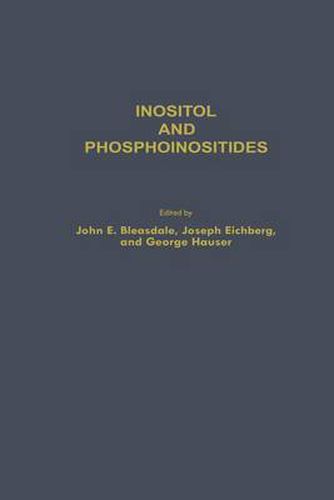Readings Newsletter
Become a Readings Member to make your shopping experience even easier.
Sign in or sign up for free!
You’re not far away from qualifying for FREE standard shipping within Australia
You’ve qualified for FREE standard shipping within Australia
The cart is loading…






This title is printed to order. This book may have been self-published. If so, we cannot guarantee the quality of the content. In the main most books will have gone through the editing process however some may not. We therefore suggest that you be aware of this before ordering this book. If in doubt check either the author or publisher’s details as we are unable to accept any returns unless they are faulty. Please contact us if you have any questions.
The Chilton Conference on Inositol and Phosphoinositides, held on January 9-11, 1984 at Southwestern Medical School, University of Texas Health Science Center, Dallas, Texas, was the third in a series of conferences on cyclitols and phosphoinositides. The first took place in 1968 in New York [Ann. New York Acad. Sci. (1969), 765,508-819] and the second was held in 1977 in East Lansing, Michigan [eyclitols and Phosphoinositides, Wells, W. W. and Eisenberg, F. , eds. , (1978) Academic press, New York, pp. 1-607.] In the interim since the previous conference, not only has the pace of research in the field accelerated markedly, but the physiological importance of phosphoinositide metabolism has become apparent to an increasing number of investigators from diverse fields in the life sciences. Thus it seemed to us timely for both recent and established workers in this area, as well as others whose interests impinged on it, to meet in order to disseminate new information, to review, and perhaps arrive at, a consensus of our current understanding of the role of inositol and phosphoinositides, and to establish new directions for research for the next few years. The expansion of the field since the last meeting made it mandatory to restrict the scope of the topics covered at the conference, primarily to aspects dealing with mammalian systems. We sincerely regretted the exclusion of recent research on cyclitols and phosphoinositides in microbes and plants and hope that these areas will be included in future conferences.
$9.00 standard shipping within Australia
FREE standard shipping within Australia for orders over $100.00
Express & International shipping calculated at checkout
This title is printed to order. This book may have been self-published. If so, we cannot guarantee the quality of the content. In the main most books will have gone through the editing process however some may not. We therefore suggest that you be aware of this before ordering this book. If in doubt check either the author or publisher’s details as we are unable to accept any returns unless they are faulty. Please contact us if you have any questions.
The Chilton Conference on Inositol and Phosphoinositides, held on January 9-11, 1984 at Southwestern Medical School, University of Texas Health Science Center, Dallas, Texas, was the third in a series of conferences on cyclitols and phosphoinositides. The first took place in 1968 in New York [Ann. New York Acad. Sci. (1969), 765,508-819] and the second was held in 1977 in East Lansing, Michigan [eyclitols and Phosphoinositides, Wells, W. W. and Eisenberg, F. , eds. , (1978) Academic press, New York, pp. 1-607.] In the interim since the previous conference, not only has the pace of research in the field accelerated markedly, but the physiological importance of phosphoinositide metabolism has become apparent to an increasing number of investigators from diverse fields in the life sciences. Thus it seemed to us timely for both recent and established workers in this area, as well as others whose interests impinged on it, to meet in order to disseminate new information, to review, and perhaps arrive at, a consensus of our current understanding of the role of inositol and phosphoinositides, and to establish new directions for research for the next few years. The expansion of the field since the last meeting made it mandatory to restrict the scope of the topics covered at the conference, primarily to aspects dealing with mammalian systems. We sincerely regretted the exclusion of recent research on cyclitols and phosphoinositides in microbes and plants and hope that these areas will be included in future conferences.